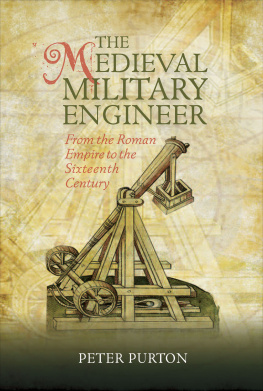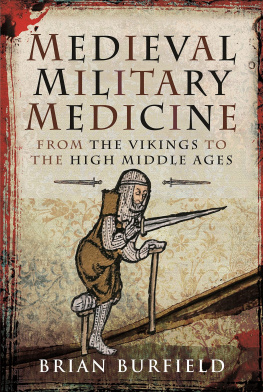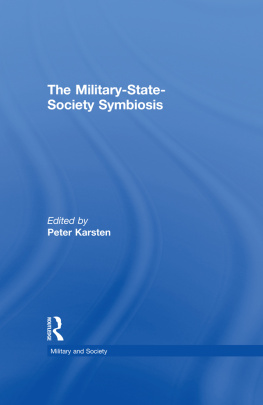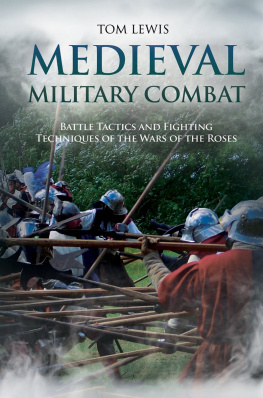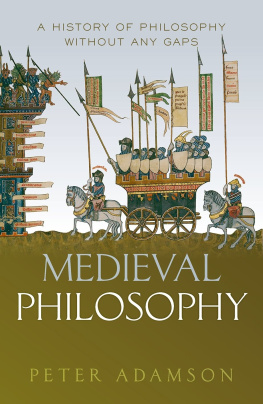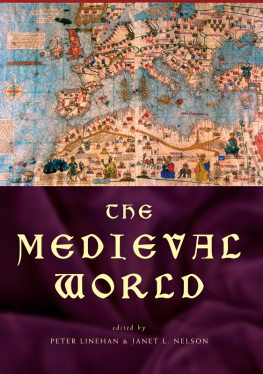Peter Purton - The Medieval Military Engineer
Here you can read online Peter Purton - The Medieval Military Engineer full text of the book (entire story) in english for free. Download pdf and epub, get meaning, cover and reviews about this ebook. year: 2018, publisher: Boydell & Brewer, genre: Religion. Description of the work, (preface) as well as reviews are available. Best literature library LitArk.com created for fans of good reading and offers a wide selection of genres:
Romance novel
Science fiction
Adventure
Detective
Science
History
Home and family
Prose
Art
Politics
Computer
Non-fiction
Religion
Business
Children
Humor
Choose a favorite category and find really read worthwhile books. Enjoy immersion in the world of imagination, feel the emotions of the characters or learn something new for yourself, make an fascinating discovery.
- Book:The Medieval Military Engineer
- Author:
- Publisher:Boydell & Brewer
- Genre:
- Year:2018
- Rating:3 / 5
- Favourites:Add to favourites
- Your mark:
- 60
- 1
- 2
- 3
- 4
- 5
The Medieval Military Engineer: summary, description and annotation
We offer to read an annotation, description, summary or preface (depends on what the author of the book "The Medieval Military Engineer" wrote himself). If you haven't found the necessary information about the book — write in the comments, we will try to find it.
The Medieval Military Engineer — read online for free the complete book (whole text) full work
Below is the text of the book, divided by pages. System saving the place of the last page read, allows you to conveniently read the book "The Medieval Military Engineer" online for free, without having to search again every time where you left off. Put a bookmark, and you can go to the page where you finished reading at any time.
Font size:
Interval:
Bookmark:

The Medieval Military Engineer
The results of medieval engineering still surround us - cathedrals, castles, stone bridges, irrigation systems. However, the siege artillery, siege towers, temporary bridges, earthwork emplacements and underground mines used for war have left little trace behind them; and there is even less of the engineers themselves: the people behind the military engineering achievements. The evidence for this neglected group is studied here.
The author begins by considering the evolution of military technology across centuries, and the impact of new technologies in the context of the economic and social developments which made them possible. He looks at how military engineers obtained their skills, and the possible link with scholastic scientific awareness. With the increased survival of government records from the middle ages, engineers acquire names and individuals can be identified. And the fifteenth century - the age of polymaths such as Leonardo da Vinci - saw a new type of literate military engineer, part of a recognized profession, but with its roots in a thousand years of historical development.
Peter Purton, D Phil (Oxon), FSA, has written extensively on medieval fortifications and siege warfare; his publications include the comprehensive two-volume history of the medieval siege (Boydell, 2010).
Armour and Weapons
ISSN 1746-9449
Series Editors
Kelly DeVries
Robert W. Jones
Robert C. Woosnam-Savage
Throughout history armour and weapons have been not merely the preserve of the warrior in battles and warfare, but potent symbols in their own right (the sword of chivalry, the heraldic shield) representing the hunt and hall as well as the battlefield. This series aims to provide a forum for critical studies of all aspects of arms and armour and their technologies, from the end of the Roman Empire to the dawn of the modern world; both new research and works of synthesis are encouraged.
New proposals for the series are welcomed; they should be sent to the publisher at the address below.
Boydell & Brewer Limited, PO Box 9, Woodbridge, Suffolk IP12 3DF, UK
Also in this series:
The Artillery of the Dukes of Burgundy, 13631477 ,
Robert Douglas Smith and Kelly DeVries
The Furie of the Ordnance: Artillery in the English Civil Wars , Stephen Bull
Jousting in Medieval and Renaissance Iberia , Noel Fallows
The Art of Swordsmanship by Hans Leckchner , translated by Jeffrey L. Forgeng
The Book of Horsemanship by Duarte I of Portugal ,
translated by Jeffrey L. Forgeng
Pietro Montes Collectanea: The Arms, Armour and Fighting Techniques of a Fifteenth-Century Soldier , translated by Jeffrey L. Forgeng

Peter Purton 2018
All rights reserved . Except as permitted under current legislation no part of this work may be photocopied, stored in a retrieval system, published, performed in public, adapted, broadcast, transmitted, recorded or reproduced in any form or by any means, without the prior permission of the copyright owner
The right of Peter Purton to be identified as the author of this work has been asserted in accordance with sections 77 and 78 of the Copyright, Designs and Patents Act 1988
First published 2018
This edition published 2018
The Boydell Press, Woodbridge
ISBN 978 1 78327 278 5 Hardback
ISBN 978 1 78744 200 9 eBook
The Boydell Press is an imprint of Boydell & Brewer Ltd
PO Box 9, Woodbridge, Suffolk IP12 3DF, UK
and of Boydell & Brewer Inc.
668 Mt Hope Avenue, Rochester, NY 146202731, USA
website: www.boydellandbrewer.com
A CIP catalogue record for this book is available
from the British Library
The publisher has no responsibility for the continued existence or accuracy of URLs for external or third-party internet websites referred to in this book, and does not guarantee that any content on such websites is, or will remain, accurate or appropriate
While many of the illustrations refer to particular points in the text, others have been chosen to illuminate aspects of the book more generally.
8Timberwork in a fifteenth-century barn at Harmondsworth,
Middlesex.
The author and publishers are grateful to all the institutions and individuals listed for permission to reproduce the materials in which they hold copyright. Every effort has been made to trace the copyright holders; apologies are offered for any omission, and the publishers will be pleased to add any necessary acknowledgement in subsequent editions.
M ANY PEOPLE HAVE HELPED me with specific references, answers to questions or general advice. With apologies for any omissions, I wish to thank (in alphabetical order) Bas Aarts, Renaud Beffeyte, Oliver Creighton, Richard Dunn, Richard Eales, Michael Fulton, Bob Higham, Christof Krauskopf, Pamela Marshall, Derek Renn, Jiri Varhanik, Peter Vemming, Olaf Wagener and Bill Woodburn. An early outline of the contents was given as a paper at Chteau Gaillard 2012 and I am grateful to have been invited to present it there. Rainer Atzbachs invitation to address the Castles at War conference in Nyborg helped me crystallise thoughts about the history of medieval military mining, and Chas Hollwey made possible a visit to the Clearwell iron mines in the Forest of Dean. Chas, and Jeremy Cunnington, made possible a visit to see medieval building techniques reconstructed at Gudelon in Burgundy. Richard Eales, Pamela Marshall and Denys Pringle have organised study tours that greatly helped me to understand medieval castles and town defences, and many members of the Castle Studies Group have contributed directly or indirectly. Finally, the anonymous referees made numerous suggestions which have saved me from errors and greatly improved this book, for which I am deeply grateful. As always, the author is responsible for all errors that remain.
P ETER P URTON , 2017
W E ARE SURROUNDED BY and sometimes still use structures dating from the middle ages. Scholarship has recreated its political, economic, social and military history. Specialists debate the finer details of medieval science, education and technology. The architecture of cathedrals, monasteries, churches and castles is painstakingly examined and re-examined and their functions are explored in both academic conferences and the popular media. But there are fewer studies of the people responsible for these works. And even fewer of military engineers who may well have been involved in both the construction and the destruction of military fortifications.
I began to ponder this even while completing my History of the Early and Late Medieval Siege. The names of engineers at war kept appearing in contemporary accounts, increasingly as more records survived. Evidently, by the time of the renaissance in Europe, a body of expertise existed that rulers called upon to fulfil their engineering needs, and some of those experts names are well known today (if the number of exhibitions devoted to Leonardo da Vinci is any guide). It is also clear that engineering continued to be undertaken across the world even when there is no surviving record of it. But what had happened before?
I was at first anxious that it would not be possible to attempt this history because of a lack of evidence. Closer study suggested that, especially for the early centuries, it was necessary to offer rather more in the way of hypothesis than a historian ought to be happy with, and to read back from later reports into earlier times, something that also involved making unprovable assumptions. Nonetheless, there was sufficient to show that this king or that prince had successfully bridged a great river, or had built engines against a hostile fortress, or had laid out and defended a camp, or had diverted a river, and thus to identify that to have done so required having access to a degree of engineering skill that it was highly unlikely the rulers themselves possessed. That the necessary technical skills also existed can be confirmed from evidence in other fields: planning, layout and construction of buildings, hydraulic engineering (canals, dams, irrigation) or shipbuilding, all areas where archaeology has added immensely to knowledge of the past. Craftsmen built ships, houses or watermills with evident skill. Although it can rarely be shown that the people who did the one also did the other, it can be demonstrated that craftsmen (anonymous) were mobilised for military campaigns.
Font size:
Interval:
Bookmark:
Similar books «The Medieval Military Engineer»
Look at similar books to The Medieval Military Engineer. We have selected literature similar in name and meaning in the hope of providing readers with more options to find new, interesting, not yet read works.
Discussion, reviews of the book The Medieval Military Engineer and just readers' own opinions. Leave your comments, write what you think about the work, its meaning or the main characters. Specify what exactly you liked and what you didn't like, and why you think so.

